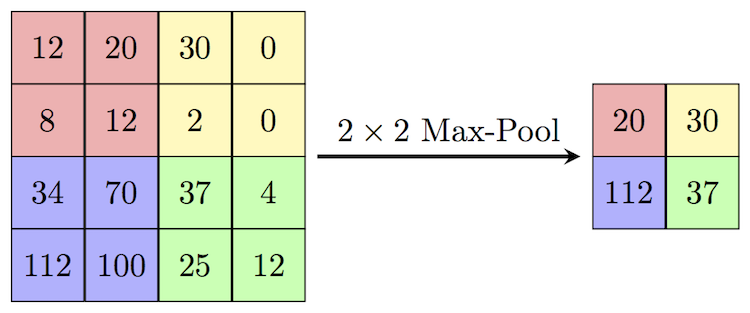Max-pooling / Pooling
Introduction
Max pooling is a sample-based discretization process(基于样例的降采样过程). The objective is to down-sample an input representation (image, hidden-layer output matrix, etc.), reducing its dimensionality and allowing for assumptions to be made about features contained in the sub-regions binned.[2]
How does it work and why
This is done to in part to help over-fitting by providing an abstracted form of the representation. As well, it reduces the computational cost by reducing the number of parameters to learn and provides basic translation invariance to the internal representation.
SUMMARY : **translation invariance**是CNN的一个非常重要的特性
Max pooling is done by applying a max filter to (usually) non-overlapping subregions of the initial representation.
Examples
Let's say we have a 4x4 matrix representing our initial input. Let's say, as well, that we have a 2x2 filter that we'll run over our input. We'll have a stride(跨度) of 2 (meaning the (dx, dy) for stepping over our input will be (2, 2)) and won't overlap regions.
For each of the regions represented by the filter, we will take the max of that region and create a new, output matrix where each element is the max of a region in the original input.
References
- http://www.flaticon.com/
- Jump up↑ https://www.quora.com/What-is-max-pooling-in-convolutional-neural-networks
A Gentle Introduction to Pooling Layers for Convolutional Neural Networks
Convolutional layers in a convolutional neural network summarize the presence of features in an input image.
A problem with the output feature maps is that they are sensitive to the location of the features in the input. One approach to address this sensitivity is to down sample the feature maps. This has the effect of making the resulting down sampled feature maps more robust to changes in the position of the feature in the image, referred to by the technical phrase “local translation invariance.”
Pooling layers provide an approach to down sampling feature maps by summarizing the presence of features in patches of the feature map. Two common pooling methods are average pooling and max pooling that summarize the average presence of a feature and the most activated presence of a feature respectively.
In this tutorial, you will discover how the pooling operation works and how to implement it in convolutional neural networks.
After completing this tutorial, you will know:
- Pooling is required to down sample the detection of features in feature maps.
- How to calculate and implement average and maximum pooling in a convolutional neural network.
- How to use global pooling in a convolutional neural network.
Discover how to build models for photo classification, object detection, face recognition, and more in my new computer vision book, with 30 step-by-step tutorials and full source code.
Let’s get started.

